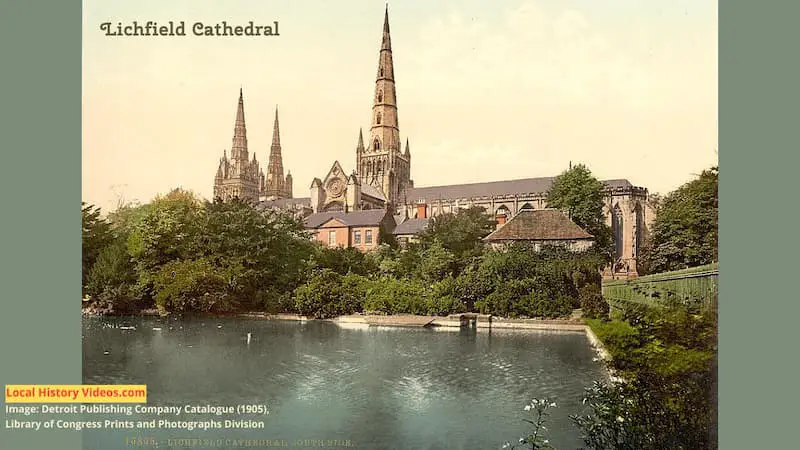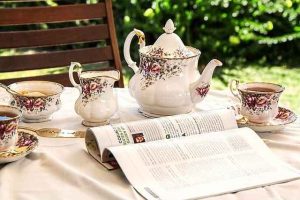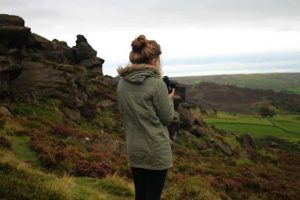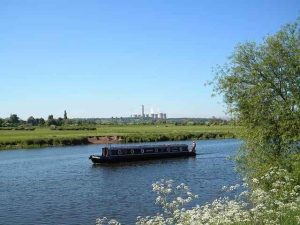Enjoy a glimpse of history through old images of Lichfield in Staffordshire, England.
Lichfield Bower
The Bower has a traditional street carnival which originates from the 12th century. Under Lichfield’s 14th century charter, twelve suits of armour must be supplied to the national defence each year. These two traditions combined, with the suits of armour worn in the annual Bower procession.
The Bower in 1927 was recorded on silent film, when floats were pulled by horses. It includes a good view of the street too.
Carnival at Lichfield Bower (1927)- British Pathé
The newsreel from 1938 says many of the suits of armour could now only fit young boys.
Litchfield Armours Aka Lichfield Armours Issue Title – Take Cover (1938) – British Pathé
New Bishop
The 94th Bishop of Lichfield, the Right Reverend Dr. Edward Woods, was enthroned in 1937, in a ceremony recorded for the newsreel. There’s a nice shot of local people outside, most facing the camera.
New Bishop Of Lichfield Enthroned (1937) – British Pathé
Houses for Young People 1965
This 1965 newsreel starts with the narrator saying “It sound incredible, but houses for renting are being build at Lichfield.”
Then we learn that the low rents of £4-15-0 for centrally heated three bedroomed homes are achievable because of pre-fabrication, with entire walls built elsewhere. That halves the number of people needed for construction, and means a house could be completed in 8-10 weeks.
“Space is used intelligently, making a house very easy to run”.
The gas fired, thermostratic controlled central heating was more exciting that it sounds, since most households across the country did not have much heating beyond a coal fire.
Lichfield – New Style Houses For Renting (1965) – British Pathé
Historic Book
Extract from: “History of the City and Cathedral of Lichfield” by John Jackson
Published 1805
Pages 42-43
In this their extreme distress, three British Kings raised a weak undisciplined army, to oppose these veteran barbarians; and the battle was fought, about the year 288, near Lichfield, where the Christian army and their three Kings were all slain, their carcases and bones burnt and heaped upon a hill, according to the ancient custom of burial after a battle, and covered with a mound of earth, or tumulus,
where, probably if dug into, the urns and ashes will be still discovered: the place is, to this day, called Barrow-cop-hill; an escutcheon or landscape of which, with the three slain Kings, or Martyrs, in several manners massacred, with a basso relievo of the present cathedral, was made the city arms; though some authors observe that Lichfield probably took its name, from its situation, and not from the cruelties practised under Dioclesian, and Maximian; Lych, in the Saxon language, signifying a marsh or morass, (which Lichfield originally was) as well as a dead body.
Pages 45- 48
From Folly – hall we proceed to the HOSPITAL
and CHAPEL in St. John’s – street .
This structure was originally a monastery ,
but when founded is not known ; though we
find that about the thirtieth year of the reign
of King Henry the First ( 1130 ) , Roger de Clin
ton , then Lord Bishop of Coventry , revised and
amended the code of statutes anciently made .
for the rule and government of the friars , & c .
This monastery was most probably one of
those religious foundations dissolved by Henry
the Sixth , in the nineteenth year of his reign
( 1441 ) , as in the tenth year of Henry the Se
venth ( 1495 ) , it was rebuilt at the expence
of William Smith , Bishop of Lichfield and Co
ventry , and by him founded as an hospital
and chapel , and dedicated to St. John the
Baptist .
The front of this building is very remarkable
for the number and antique form of its chimneys ;
and over the door is a Latin inscription , thus
rendered in English .
” This is the hospital of St. John the Baptist ,
which that venerable prelate William Smith , for
merly Lord Bishop of this see , erected , in the
year 1495 , for a master and thirteen poor men .
” The same munificent patron also founded
Brazen – nose college , in Oxford .
” And , ‘ to his memory , Edward Maynard ,
master of this hospital , set up this table , in the
year of our Lord , 1720. “
Bishop Smith enfeoffed this hospital with
divers lands and tenements , for the mainte
´nance of a master , two priests , and thirteen
poor men ; on whom King Henry the Seventh
settled all the revenues of the hospital of Den
hall , at Wyrehall , in the county of Chester ,
together with the profits of the impropriate church
of Burton , for ever . We have reason to con
clude that the chief of these endowments have
long since been alienated from this hospital . * ;
yet , by the munificence of several benevolent
persons , it is still possessed of a handsome estate ,
and great privileges . The charter , granted by
King Charles II . to the citizens of Lichfield
contains a special reservation , that the master
of this hospital shall not be prejudiced by the
said charter .
Nearly opposite is the FREE GRAMMAR
SCHOOL , founded by Bishop Smith at the time
he erected the hospital . Many of the brightest
ornaments of the last and of the present century
are indebted to this school for the rudiments of
their education . The present master is the Rev.
T. Harwood , of Trinity College , Oxford .
In the adjacent spacious street , called Boar
street , is an English free – school , the new Theatre ,
and the Guildhall .
‘ The ENGLISH FREE – SCHOOL is an ancient
building , erccted and endowed by Thomas Mi
nors , esq . in the year 1670 , for the teaching
of thirty poor boys to read the Bible in English .
The THEATRE is a newly erected building ,
with a stucco front . The interior part is spa
cious , and the boxes , stage , & c . neatly deco
rated . It is now the property of a society of
gentlemen .
The GUILDHALL is a neat stone edifice ,
ornamented with the city arms . The Guild
and Guild – master , by which this town was
originally governed , usually assembled in this
place . King Richard the First enabled the
Guild to purchase lands to the value of ten
pounds . At the back part of the hall , there is a
GAOL , for confining debtors and felons ap
prehended within the boundaries of the city and
county of Lichfield.
More about Staffordshire
- Old Images of Staffordshire, EnglandGlimpse history through old images of Staffordshire, England, UK.
- Old Images of Lichfield, StaffordshireEnjoy a glimpse of history through old images of Lichfield in Staffordshire, England. Lichfield Bower The Bower has a traditional street carnival which originates from the 12th century. Under Lichfield’s 14th century charter, twelve suits of armour must be supplied to the national defence each year. These two traditions combined, with the suits of armour worn in… Read more: Old Images of Lichfield, Staffordshire
- Burton upon Trent: Looking Back At Recent HistoryA previous post looked at photos and videos of Burton in the past century. Now we take a look at the Staffordshire town on film in the first few years of the 21st Century. Spot the changes to the local area since this recent past, and see if you recognise anyone. Burton On Trent Buses… Read more: Burton upon Trent: Looking Back At Recent History
- Stoke-on-Trent, StaffordshireStoke-On-Trent became a city in 1910 by amalgamating 6 Staffordshire towns. Internationally renowned for its pottery trade, the city is commonly called the Potteries. As manufacturing declined, footage moves its focus across to the daily lives and leisure of the city’s local residents.
- Leek: Local History In Old Photos & FilmThe market town of Leek is in the English county of Staffordshire. It’s about 10 miles (or 16 kilometres) north east of Stoke-on-Trent, next to the River Churnet, and has easy access to excellent walking terrain in the Peak District National Park.
- Burton On Trent History In Old Photos And Film
- Staffordshire, a County In EnglandVideos of the city of Stafford and the County of Staffordshire reflect the changing nature of this part of the West Midlands in the UK.






